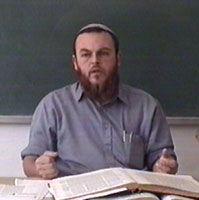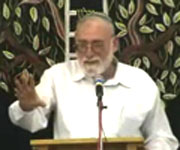Beit Midrash
- Torah Portion and Tanach
- Bereshit
- Noach
Translated by Hillel Fendel
This week's Torah portion of Noah takes us up to (and past) the birth of Avraham Avinu, in the year 1948 after Creation – and nary a word seems to be mentioned about the Land of Israel throughout these almost two millennia!
Is this not very strange, considering that the Foundation Stone – Even HaShtiyah – from where the world was actually created, is located in the Land, on what later became the Temple Mount? The longed-for Garden of Eden, too, is located in our Holy Land. How could the Land play such a minor role in the first 2,000 years of human history?
Maimonides states as follows (paraphrased from Laws of the Chosen House 2,1-2):
"The Altar is located very precisely and the place may never be changed… It is universally accepted that David and Shlomo built altars on the same spot as the site of the Binding of Yitzchak, namely, "in Jerusalem, on Mt. Moriah, where G-d had appeared to Shlomo's father David" (Chronicles II 3,1). And Noah built an altar on that location when he left the ark. It was also the site of the altar on which Cain and Abel brought sacrifices. Adam, too, offered a sacrifice there, and was created at that very spot, as our Sages said: "Man was created from the place where he [would find] atonement."
A careful study of Parshat Noah reveals that Eretz Yisrael does in fact play an important role in the events before Avraham. We first note that the first half of the Parsha tells the story of the Flood – which did not engulf Eretz Yisrael, as R. Yochanan states in the Talmud (Zevachim 113a), and as R. Levi states in the Midrash (Shir HaShirim Rabba 4). Their opinion finds supports in G-d's words to the Prophet Yehezkel: "Son of man, say [about] the Land, 'It was not cleansed, not rained upon on the day of fury'" (Yechezkel 22,24).
This teaching of the Sages is a clear and deep message that our Holy Land is truly special, and is certainly set apart from all the other places that the Bible speaks of.
The second half of Parshat Noah places a particularly negative emphasis on two of Noah's grandsons, Canaan and Cush, sons of Ḥam. According to one understanding of B'reshit 9,24, Ḥam was the youngest son of Noah, and Canaan was the youngest son of Ḥam. Canaan and Ḥam acted towards Noah in a most vile manner, and therefore G-d's grave response was to "curse" them (B'reshit 9,25) – similar to G-d's response to the primordial serpent (3,14-17). [Canaan, of course, was the namesake of the Holy Land before it was given to the children of Yaakov.]
This leads us to Nimrod, the great rebel against the Creator of the World and the eldest son of Cush. The Torah says that Nimrod was the prototype of a "great hunting warrior before G-d" (10,9) – meaning that he caused the entire world to rebel against G-d by building the Tower of Babel. It was via Nimrod that Avraham, who refused to accept Nimrod's heresy, first became famous, in surviving the furnace into which Nimrod threw him.
The eldest son of Canaan was Tsidon, whose city became the north-western boundary of the Land of Canaan. The destructive influence of the descendants of Canaan reached all the way up to "S'dom, Amora, Admah, and Tzvoyim, up to Lasha [the cities of the Great Plain, near today's Dead Sea]" (10,19). These became the symbol of evil and destruction for generations to come, and even today.
Parshat Noah, then, is a type of introduction to the story of the Nation of Israel, the descendants of Avraham, Yitzchak and Yaakov, and Sarah, Rivka, Rachel and Leah.
The Journey Begins Here
Avraham Avinu's journey to Eretz Yisrael begins at the end of Parshat Noah. The first part of the portion explains why Eretz Yisrael was chosen of all places – and the answer is that this is the place where it is possible and required to live in sanctity and purity, and therefore it did not need to purified by the rains of the Flood.
And the second part of Parshat Noah explains why Avraham Avinu was sent there – because it was the place ["the cities of the Plain"] that required the most rectification following the Flood, in the wake of the terrible sins of the descendants of Ḥam.
We have merited in our generation to take an active part in the mitzvah of settling the Land, and turning the Land of Canaan into the Land of Israel. Let us pray that we merit to walk in the path of Avraham, the path of charity and justice, and to reveal the special potential of the Land, and to become a positive alternative to the followers of Ḥam, Canaan, Nimrod and the inhabitants of the cities of the Plain.
This week's Torah portion of Noah takes us up to (and past) the birth of Avraham Avinu, in the year 1948 after Creation – and nary a word seems to be mentioned about the Land of Israel throughout these almost two millennia!
Is this not very strange, considering that the Foundation Stone – Even HaShtiyah – from where the world was actually created, is located in the Land, on what later became the Temple Mount? The longed-for Garden of Eden, too, is located in our Holy Land. How could the Land play such a minor role in the first 2,000 years of human history?
Maimonides states as follows (paraphrased from Laws of the Chosen House 2,1-2):
"The Altar is located very precisely and the place may never be changed… It is universally accepted that David and Shlomo built altars on the same spot as the site of the Binding of Yitzchak, namely, "in Jerusalem, on Mt. Moriah, where G-d had appeared to Shlomo's father David" (Chronicles II 3,1). And Noah built an altar on that location when he left the ark. It was also the site of the altar on which Cain and Abel brought sacrifices. Adam, too, offered a sacrifice there, and was created at that very spot, as our Sages said: "Man was created from the place where he [would find] atonement."
A careful study of Parshat Noah reveals that Eretz Yisrael does in fact play an important role in the events before Avraham. We first note that the first half of the Parsha tells the story of the Flood – which did not engulf Eretz Yisrael, as R. Yochanan states in the Talmud (Zevachim 113a), and as R. Levi states in the Midrash (Shir HaShirim Rabba 4). Their opinion finds supports in G-d's words to the Prophet Yehezkel: "Son of man, say [about] the Land, 'It was not cleansed, not rained upon on the day of fury'" (Yechezkel 22,24).
This teaching of the Sages is a clear and deep message that our Holy Land is truly special, and is certainly set apart from all the other places that the Bible speaks of.
The second half of Parshat Noah places a particularly negative emphasis on two of Noah's grandsons, Canaan and Cush, sons of Ḥam. According to one understanding of B'reshit 9,24, Ḥam was the youngest son of Noah, and Canaan was the youngest son of Ḥam. Canaan and Ḥam acted towards Noah in a most vile manner, and therefore G-d's grave response was to "curse" them (B'reshit 9,25) – similar to G-d's response to the primordial serpent (3,14-17). [Canaan, of course, was the namesake of the Holy Land before it was given to the children of Yaakov.]
This leads us to Nimrod, the great rebel against the Creator of the World and the eldest son of Cush. The Torah says that Nimrod was the prototype of a "great hunting warrior before G-d" (10,9) – meaning that he caused the entire world to rebel against G-d by building the Tower of Babel. It was via Nimrod that Avraham, who refused to accept Nimrod's heresy, first became famous, in surviving the furnace into which Nimrod threw him.
The eldest son of Canaan was Tsidon, whose city became the north-western boundary of the Land of Canaan. The destructive influence of the descendants of Canaan reached all the way up to "S'dom, Amora, Admah, and Tzvoyim, up to Lasha [the cities of the Great Plain, near today's Dead Sea]" (10,19). These became the symbol of evil and destruction for generations to come, and even today.
Parshat Noah, then, is a type of introduction to the story of the Nation of Israel, the descendants of Avraham, Yitzchak and Yaakov, and Sarah, Rivka, Rachel and Leah.
The Journey Begins Here
Avraham Avinu's journey to Eretz Yisrael begins at the end of Parshat Noah. The first part of the portion explains why Eretz Yisrael was chosen of all places – and the answer is that this is the place where it is possible and required to live in sanctity and purity, and therefore it did not need to purified by the rains of the Flood.
And the second part of Parshat Noah explains why Avraham Avinu was sent there – because it was the place ["the cities of the Plain"] that required the most rectification following the Flood, in the wake of the terrible sins of the descendants of Ḥam.
We have merited in our generation to take an active part in the mitzvah of settling the Land, and turning the Land of Canaan into the Land of Israel. Let us pray that we merit to walk in the path of Avraham, the path of charity and justice, and to reveal the special potential of the Land, and to become a positive alternative to the followers of Ḥam, Canaan, Nimrod and the inhabitants of the cities of the Plain.
























